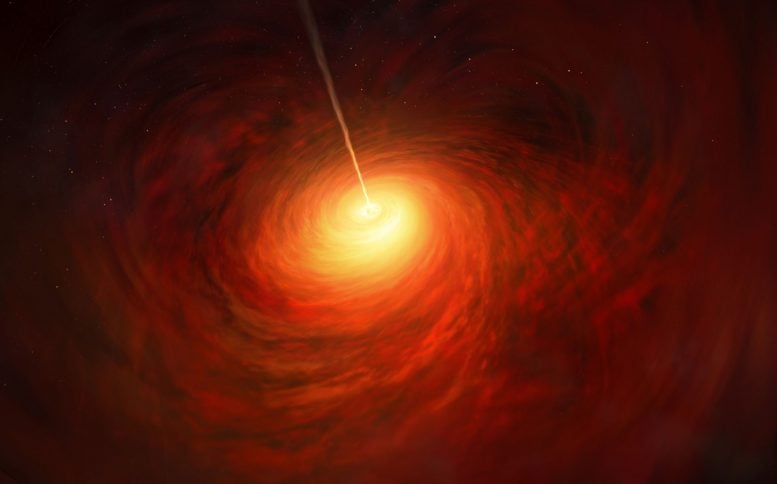
This artist’s impression depicts the black hole at the heart of the enormous elliptical galaxy Messier 87 (M87). This black hole was chosen as the object of paradigm-shifting observations by the Event Horizon Telescope. The superheated material surrounding the black hole is shown, as is the relativistic jet launched by M87’s black hole. Credit: ESO/M. Kornmesser
The Event Horizon Telescope (EHT) — a planet-scale array of eight ground-based radio telescopes forged through international collaboration — was designed to capture images of a black hole. Today, in coordinated press conferences across the globe, EHT researchers reveal that they have succeeded, unveiling the first direct visual evidence of a supermassive black hole and its shadow.
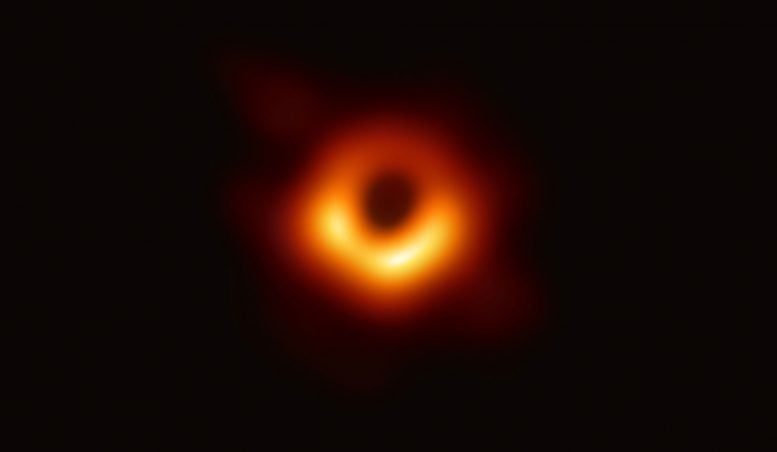
In coordinated press conferences across the globe, EHT researchers revealed that they succeeded, unveiling the first direct visual evidence of the supermassive black hole in the center of Messier 87 and its shadow. The shadow of a black hole seen here is the closest we can come to an image of the black hole itself, a completely dark object from which light cannot escape. The black hole’s boundary — the event horizon from which the EHT takes its name — is around 2.5 times smaller than the shadow it casts and measures just under 40 billion km across. While this may sound large, this ring is only about 40 microarcseconds across — equivalent to measuring the length of a credit card on the surface of the Moon.
This breakthrough was announced today in a series of six papers published in a special issue of The Astrophysical Journal Letters. The image reveals the black hole at the center of Messier 87, a massive galaxy in the nearby Virgo galaxy cluster. This black hole resides 55 million light-years from Earth and has a mass 6.5 billion times that of the Sun.
The EHT links telescopes around the globe to form an unprecedented Earth-sized virtual telescope. The EHT offers scientists a new way to study the most extreme objects in the Universe predicted by Einstein’s general relativity during the centenary year of the historic experiment that first confirmed the theory.
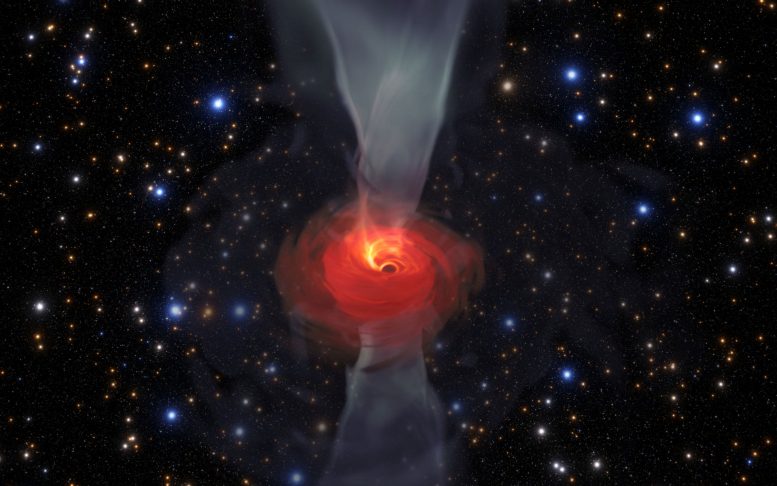
In anticipation of the first image of a black hole, Jordy Davelaar and colleagues built a virtual reality simulation of one of these fascinating astrophysical objects. Their simulation shows a black hole surrounded by luminous matter. This matter disappears into the black hole in a vortex-like way, and the extreme conditions cause it to become a glowing plasma. The light emitted is then deflected and deformed by the powerful gravity of the black hole. Credit: Jordy Davelaar et al./Radboud University/BlackHoleCam
“We have taken the first picture of a black hole,” said EHT project director Sheperd S. Doeleman of the Center for Astrophysics | Harvard & Smithsonian. “This is an extraordinary scientific feat accomplished by a team of more than 200 researchers.”
Black holes are extraordinary cosmic objects with enormous masses but extremely compact sizes. The presence of these objects affects their environment in extreme ways, warping spacetime and superheating any surrounding material.
“If immersed in a bright region, like a disc of glowing gas, we expect a black hole to create a dark region similar to a shadow — something predicted by Einstein’s general relativity that we’ve never seen before,” explained chair of the EHT Science Council Heino Falcke of Radboud University, the Netherlands. “This shadow, caused by the gravitational bending and capture of light by the event horizon, reveals a lot about the nature of these fascinating objects and has allowed us to measure the enormous mass of M87’s black hole.”
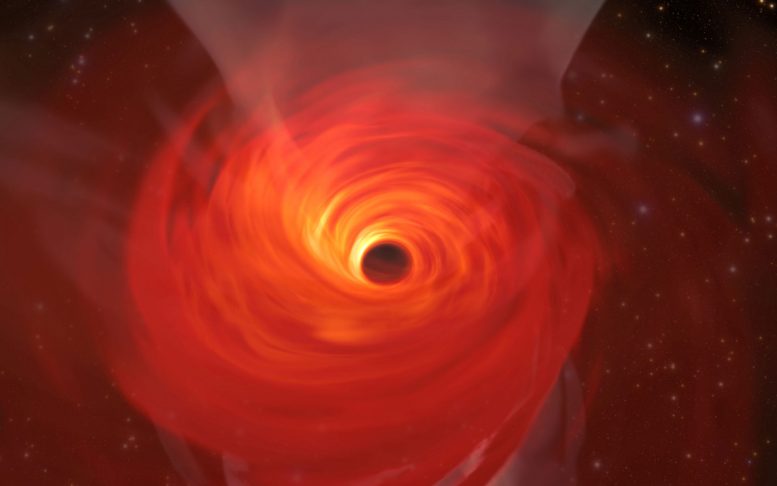
In anticipation of the first image of a black hole, Jordy Davelaar and colleagues built a virtual reality simulation of one of these fascinating astrophysical objects. Their simulation shows a black hole surrounded by luminous matter. This matter disappears into the black hole in a vortex-like way, and the extreme conditions cause it to become a glowing plasma. The light emitted is then deflected and deformed by the powerful gravity of the black hole. Credit: Jordy Davelaar et al./Radboud University/BlackHoleCam
Multiple calibrations and imaging methods have revealed a ring-like structure with a dark central region — the black hole’s shadow — that persisted over multiple independent EHT observations.
“Once we were sure we had imaged the shadow, we could compare our observations to extensive computer models that include the physics of warped space, superheated matter, and strong magnetic fields. Many of the features of the observed image match our theoretical understanding surprisingly well,” remarks Paul T.P. Ho, EHT Board member and Director of the East Asian Observatory. “This makes us confident about the interpretation of our observations, including our estimation of the black hole’s mass.”
“The confrontation of theory with observations is always a dramatic moment for a theorist. It was a relief and a source of pride to realize that the observations matched our predictions so well,” elaborated EHT Board member Luciano Rezzolla of Goethe Universität, Germany.
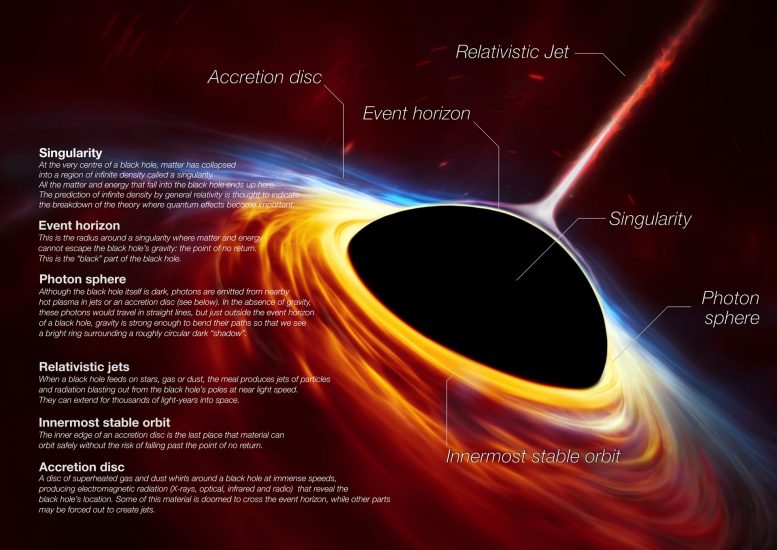
This artist’s impression depicts a rapidly spinning supermassive black hole surrounded by an accretion disc. This thin disc of rotating material consists of the leftovers of a Sun-like star which was ripped apart by the tidal forces of the black hole. The black hole is labeled, showing the anatomy of this fascinating object. Credit: ESO
Creating the EHT was a formidable challenge which required upgrading and connecting a worldwide network of eight pre-existing telescopes deployed at a variety of challenging high-altitude sites. These locations included volcanoes in Hawai`i and Mexico, mountains in Arizona and the Spanish Sierra Nevada, the Chilean Atacama Desert, and Antarctica.
The EHT observations use a technique called very-long-baseline interferometry (VLBI) which synchronizes telescope facilities around the world and exploits the rotation of our planet to form one huge, Earth-size telescope observing at a wavelength of 1.3mm. VLBI allows the EHT to achieve an angular resolution of 20 micro-arcseconds — enough to read a newspaper in New York from a café in Paris.
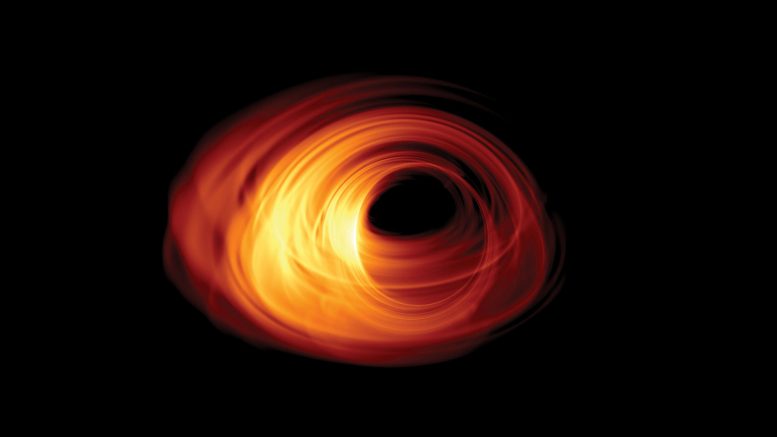
Simulated image of an accreting black hole. The event horizon is in the middle of the image, and the shadow can be seen with a rotating accretion disk surrounding it. Credit: Bronzwaer/Davelaar/Moscibrodzka/Falcke/Radboud University
The telescopes contributing to this result were ALMA, APEX, the IRAM 30-meter telescope, the James Clerk Maxwell Telescope, the Large Millimeter Telescope Alfonso Serrano, the Submillimeter Array, the Submillimeter Telescope, and the South Pole Telescope. Petabytes of raw data from the telescopes were combined by highly specialized supercomputers hosted by the Max Planck Institute for Radio Astronomy and MIT Haystack Observatory.
European facilities and funding played a crucial role in this worldwide effort, with the participation of advanced European telescopes and the support from the European Research Council — particularly a €14 million grant for the BlackHoleCam project. Support from ESO, IRAM, and the Max Planck Society was also key. “This result builds on decades of European expertise in millimeter astronomy,” commented Karl Schuster, Director of IRAM and member of the EHT Board.
The Event Horizon Telescope (EHT) — a planet-scale array of eight ground-based radio telescopes forged through international collaboration — was designed to capture images of a black hole. In coordinated press conferences across the globe, EHT researchers revealed that they succeeded, unveiling the first direct visual evidence of a supermassive black hole and its shadow. This 17-minute film explores the efforts that led to this historic image, from the science of Einstein and Schwarzschild to the struggles and successes of the EHT collaboration. Credit: ESO
The construction of the EHT and the observations announced today represent the culmination of decades of observational, technical, and theoretical work. This example of global teamwork required close collaboration by researchers from around the world. Thirteen partner institutions worked together to create the EHT, using both pre-existing infrastructure and support from a variety of agencies. Key funding was provided by the US National Science Foundation (NSF), the EU’s European Research Council (ERC), and funding agencies in East Asia.
The Event Horizon Telescope (EHT) — a planet-scale array of eight ground-based radio telescopes forged through international collaboration — was designed to capture images of a black hole. In coordinated press conferences across the globe, EHT researchers revealed that they succeeded, unveiling the first direct visual evidence of a supermassive black hole and its shadow.
“ESO is delighted to have significantly contributed to this result through its European leadership and pivotal role in two of the EHT’s component telescopes, located in Chile — ALMA and APEX,” commented ESO Director General Xavier Barcons. “ALMA is the most sensitive facility in the EHT, and its 66 high-precision antennas were critical in making the EHT a success.”
In anticipation of the first image of a black hole, Jordy Davelaar and colleagues built a virtual reality simulation of one of these fascinating astrophysical objects. Their simulation shows a black hole surrounded by luminous matter. This matter disappears into the black hole in a vortex-like way, and the extreme conditions cause it to become a glowing plasma. The light emitted is then deflected and deformed by the powerful gravity of the black hole.
“We have achieved something presumed to be impossible just a generation ago,” concluded Doeleman. “Breakthroughs in technology, connections between the world’s best radio observatories, and innovative algorithms all came together to open an entirely new window on black holes and the event horizon.”
This artist’s impression depicts the black hole at the heart of the enormous elliptical galaxy M87. This black hole was chosen as the object of paradigm-shifting observations by the Event Horizon Telescope. The superheated material surrounding the black hole is shown.
This artist’s impression depicts the black hole at the heart of the enormous elliptical galaxy M87. This black hole was chosen as the object of paradigm-shifting observations by the Event Horizon Telescope. The superheated material surrounding the black hole is shown, as is the relativistic jet launched by M87’s black hole.
References:
- “First M87 Event Horizon Telescope Results. I. The Shadow of the Supermassive Black Hole” by The Event Horizon Telescope Collaboration, 10 April 2019, The Astrophysical Journal Letters.
DOI: 10.3847/2041-8213/ab0ec7 - “First M87 Event Horizon Telescope Results. II. Array and Instrumentation” by The Event Horizon Telescope Collaboration, 10 April 2019, The Astrophysical Journal Letters.
DOI: 10.3847/2041-8213/ab0c96 - “First M87 Event Horizon Telescope Results. III. Data Processing and Calibration” by The Event Horizon Telescope Collaboration, 10 April 2019, The Astrophysical Journal Letters.
DOI: 10.3847/2041-8213/ab0c57 - “First M87 Event Horizon Telescope Results. IV. Imaging the Central Supermassive Black Hole” by The Event Horizon Telescope Collaboration, 10 April 2019, The Astrophysical Journal Letters.
DOI: 10.3847/2041-8213/ab0e85 - “First M87 Event Horizon Telescope Results. V. Physical Origin of the Asymmetric Ring” by The Event Horizon Telescope Collaboration, 10 April 2019, The Astrophysical Journal Letters.
DOI: 10.3847/2041-8213/ab0f43 - “First M87 Event Horizon Telescope Results. VI. The Shadow and Mass of the Central Black Hole” by The Event Horizon Telescope Collaboration, 10 April 2019, The Astrophysical Journal Letters.
DOI: 10.3847/2041-8213/ab1141




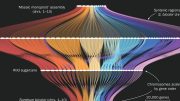




So I realized that he close up image of this black hole is very blurred and people keep raising all these questions about what we don’t know about these things. my question in suggestion as well would be why don’t we take the New horizon spacecraft and fly it directly into the black hole and keep the camera rolling. instead of just taking a picture from millions of light years away that’s blurry. Wouldn’t we learn more about this black hole if we were to just do that. Obviously we’ve spent lots and lots of money to make the New horizon spacecraft but sacrificing it could mean so many different answers to questions that I’m sure has baffled scientists forever. I would really like to see New horizons head for this black hole while taking constant snapshots and or rolling video so we can gain the experience of what a black hole would do to an object. I doubt it will happen but I just had to hope if the possibility
The bestest known black hole is 27000 light years away. No matter the speed you travel it will take 27000 minimum years to get there and then a minimum 27000 years to send the data back to earth. 54000 years from now if we start now and can send a problem at the speed of light we will see this image you want.
Good luck
I’m certain the spacecraft and everything on it would be destroyed before entering the black hole. Everything around the black hole that nears it is so heated it turns into plasma before being sucked in. And even if we could get data from inside a black hole, how would we get that data transmitted back out? How could any frequency be emitted from inside a black hole and escape the black hole to broadcast a signal back to us? It probably isn’t possible to know what happens inside a black hole through any actual physical measurement. We have to measure it by what we can detect from the outside.
So you summarize the discovery with no mention of the person who lead the project to process and display the first image? You mentioned a lot of folks, and yet conveniently ignore someone who was pretty important and who is currently under attack for it.
Nice similation!
Earl
The focus was on the matter involved in the six papers published today. Bouman’s name appears several times in those papers, referencing her and her colleagues previous work, but she is not a (co-) author of any of the six, let alone a lead author.
@ Robert Nelson: Even if we had a camera at the nearest black hole (V616 Monocerotis) beaming a signal at us right this very instant, the signal would still take 3,000 years to reach us! Meanwhile, getting a camera there using current methods is… effectively pointless. Of course, if I’m missing something about your plan, please let us know.
@ some random person
While it is true that it is effective pointless, it remains so only to our time.
We can hope that eventually the future will be better, but in the event it is not, they may yet find signal to view that spacecraft’s live feed in the far future (even if it’s the relevant past, theres many answers and new questions coming forth as Robert has suggested).
While it is a waste of “our” resource, and we wont reap anything from it, humans in general (future generations) may have a slim chance yet to reap from it.
End of the world?
I WANT TO BE ABLE TO TRAVEL THROUGH TIME!! CAN YOU PLEASE HELP ME???
I can help, Jason! Uh, you ARE traveling through time, along with all the rest of us. Wish granted!
Chandaryaan2 new record https://www.sarthtya.tech/2019/11/chandaryaan2-chandaryaan2-new-record.html?m=1
This image is questionable. I certainly donlt accept that this is a true image of a Black Hole. The datasets from the radiotelescopes do not support it. There’s something fishy going on here.